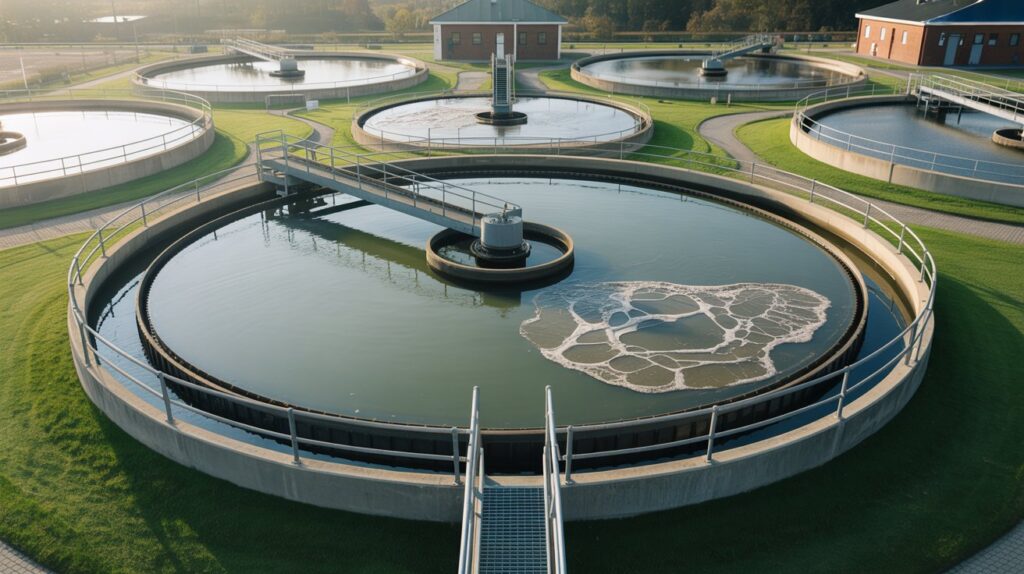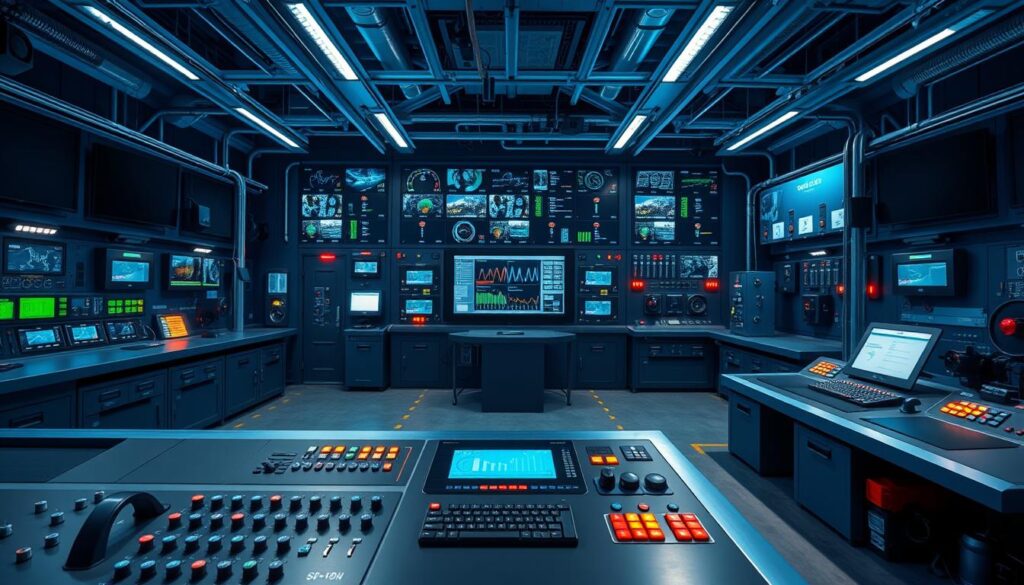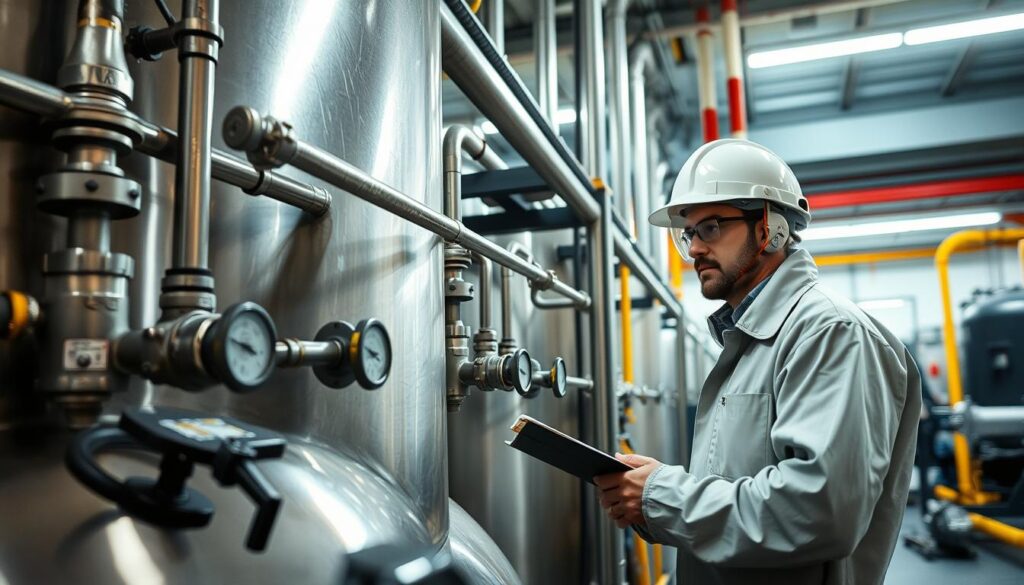Are you aware of the critical role that regular inspections play in maintaining the efficiency of wastewater treatment processes? Proper inspection of equipment such as aeration basins and centrifugal pumps is not just a routine task; it’s a crucial step in ensuring that wastewater treatment plants operate smoothly and comply with environmental regulations.
Regular inspections help identify potential issues before they become major problems, reducing downtime and improving overall efficiency. As highlighted recently, maintaining your wastewater pump is crucial for the longevity of your equipment and the quality of the treated water.
Key Takeaways
- Regular inspections are crucial for maintaining efficient wastewater treatment operations.
- Proper maintenance of equipment like aeration basins and centrifugal pumps is essential.
- Early detection of issues can significantly reduce downtime and costs.
- Compliance with environmental regulations is ensured through regular inspections.
- Efficient operation of wastewater treatment plants relies on well-maintained equipment.
The Critical Importance of Regular Wastewater Equipment Inspections
The importance of regular wastewater equipment inspections cannot be overstated, as they play a vital role in ensuring the smooth operation of treatment facilities. Regular maintenance is essential for optimizing production, reducing repair costs, and ensuring environmental benefits.
Ensuring Regulatory Compliance is one of the primary reasons regular inspections are crucial. Wastewater treatment plants must adhere to stringent regulatory requirements to avoid fines and legal repercussions. Regular inspections help ensure that all equipment is functioning within these regulatory standards.
Regulatory Compliance Requirements
Wastewater treatment facilities are subject to various environmental regulations that mandate regular equipment inspections. Compliance with these regulations is not only legally necessary but also contributes to the overall safety and efficiency of the facility. Inspecting equipment regularly helps identify potential issues before they become major problems, thus ensuring continuous compliance.
Cost Savings Through Preventative Maintenance
Regular inspections facilitate preventative maintenance, which is significantly more cost-effective than repairing or replacing equipment after it fails. By identifying wear and tear early, maintenance can be scheduled during off-peak hours, reducing downtime and the costs associated with emergency repairs.
Moreover, preventative maintenance extends the lifespan of equipment, delaying the need for costly replacements. This proactive approach not only saves money but also enhances the overall reliability of the wastewater treatment process.
Environmental Protection Benefits
Regular inspections of wastewater equipment are also vital for environmental protection. Properly functioning equipment ensures that wastewater is treated effectively, minimizing the risk of environmental contamination. Inspections help identify potential issues that could lead to equipment failure, thereby preventing harmful discharges into the environment.
By maintaining equipment in good working order, wastewater treatment facilities can significantly reduce their environmental footprint. This not only protects local ecosystems but also contributes to a healthier environment for surrounding communities.
Essential Safety Protocols for Inspecting Wastewater Equipment
Safety protocols are paramount when inspecting wastewater equipment, as they help mitigate risks and protect workers from potential hazards. Inspecting wastewater treatment equipment involves navigating complex systems and potentially hazardous environments, making safety protocols indispensable.
Personal Protective Equipment Requirements
Inspectors must wear appropriate personal protective equipment (PPE) to safeguard against chemical splashes, biological contaminants, and other hazards. This typically includes gloves, safety glasses, face masks, and protective clothing. Ensuring that PPE is in good condition and properly fitted is crucial for effective protection.
Confined Space Entry Procedures
Many wastewater equipment inspections involve entering confined spaces, which poses significant risks. To mitigate these risks, inspectors must follow confined space entry procedures, including obtaining permits, ventilating the area, and using safety harnesses. Training in confined space entry is essential for all personnel involved in inspections.
Lockout/Tagout Protocols
Lockout/tagout (LOTO) protocols are critical for preventing accidental equipment startup during inspections. This involves isolating energy sources, locking out equipment, and tagging it to indicate that maintenance is being performed. Proper LOTO procedures protect inspectors from unexpected machinery activation.
Chemical Exposure Prevention
Chemical exposure is a significant risk during wastewater equipment inspections, particularly when dealing with chemical feed systems. Inspectors should be aware of the chemicals used in the process and take measures to minimize exposure, such as using chemical-resistant PPE and following established safety protocols for handling chemicals.
| Safety Protocol | Description | Importance Level |
|---|---|---|
| Personal Protective Equipment | Gloves, safety glasses, face masks, protective clothing | High |
| Confined Space Entry | Permit acquisition, ventilation, safety harnesses | High |
| Lockout/Tagout | Isolating energy sources, locking out equipment, tagging | Critical |
| Chemical Exposure Prevention | Chemical-resistant PPE, safe handling practices | High |
Developing an Effective Inspection Schedule and Checklist
An effective inspection schedule and checklist are essential tools for ensuring the reliability and efficiency of wastewater treatment processes. Developing a maintenance schedule based on manufacturer recommendations and operational conditions is crucial for preventing equipment failures and reducing downtime.
Frequency Considerations Based on Equipment Type
The frequency of inspections should be determined by the type of equipment and its criticality to the treatment process. For instance, filtration units and other critical equipment may require more frequent inspections compared to less critical components.
Creating Comprehensive Inspection Checklists
A comprehensive inspection checklist should include items such as:
- Visual inspections for signs of wear or damage
- Lubrication checks
- Vibration analysis
- Temperature monitoring
Documentation and Record-Keeping Best Practices
Proper documentation and record-keeping are vital for tracking equipment performance and identifying potential issues before they become major problems.
Digital vs. Paper Documentation Systems
While traditional paper-based systems are still used, digital documentation systems offer several advantages, including easier data analysis, improved accessibility, and reduced storage space. Digital systems can also facilitate the integration of inspection data with other maintenance management systems.
Pumping Systems Inspection Guidelines
Regular inspection of pumping systems is crucial for maintaining efficiency and preventing unexpected failures in wastewater treatment processes. Pumping systems, including centrifugal and positive displacement pumps, are critical components that require regular maintenance to ensure they operate effectively.
Centrifugal Pump Inspection Procedures
Centrifugal pumps are widely used in wastewater treatment for their ability to handle large volumes of fluid. Inspecting these pumps involves checking for signs of wear on the impeller and volute, ensuring proper alignment, and verifying that the pump is operating within its designed parameters.
- Check for unusual vibrations or noises
- Inspect seals for leaks or damage
- Verify lubrication of bearings
Positive Displacement Pump Assessment
Positive displacement pumps are used for their ability to provide a consistent flow rate regardless of pressure. Inspection procedures include checking the condition of the rotor and stator, inspecting for signs of wear or damage on the pump’s internal components, and ensuring that the pump’s performance matches its specification.
| Pump Type | Inspection Focus | Common Issues |
|---|---|---|
| Centrifugal | Impeller condition, alignment | Vibration, cavitation |
| Positive Displacement | Rotor and stator condition | Wear, overheating |
Common Pump Failure Points to Monitor
Pumps in wastewater treatment plants are subject to various stresses that can lead to failure if not properly monitored. Common failure points include seals, bearings, and impellers in centrifugal pumps, and rotors and stators in positive displacement pumps.
Seal and Bearing Inspection Techniques
Inspecting seals and bearings involves checking for signs of wear, damage, or overheating. Techniques include visual inspection, vibration analysis, and temperature monitoring. Regular lubrication of bearings is also crucial to prevent premature failure.
By following these guidelines for inspecting pumping systems, wastewater treatment plants can reduce the risk of equipment failure, improve operational efficiency, and extend the lifespan of their pumps.
Aeration System Inspection Techniques
The efficiency of wastewater treatment plants heavily relies on the proper functioning of aeration systems, which requires regular inspection. Aeration systems are critical for providing the oxygen needed to support biological processes that break down organic matter in wastewater.
Blower and Diffuser Inspection Methods
Inspecting blowers and diffusers is crucial for maintaining optimal aeration system performance. Blowers should be checked for signs of wear, vibration, and proper lubrication. Diffusers, on the other hand, should be inspected for fouling or clogging, which can significantly reduce oxygen transfer efficiency.
Regular cleaning and maintenance of diffusers can help prevent such issues. It’s also essential to check the blower’s motor and electrical connections for any signs of damage or malfunction.
Surface Aerator Maintenance Checks
Surface aerators require regular maintenance to ensure they continue to operate effectively. This includes checking for mechanical wear on the aerator’s shaft, gearbox, and motor. Lubrication levels should be verified, and any signs of leakage should be addressed promptly.
Additionally, the aerator’s impeller should be inspected for damage or imbalance, as this can significantly impact its efficiency. Ensuring that the aerator is properly aligned and securely fastened is also crucial.
Identifying Efficiency Issues in Aeration Basins
Aeration basins are a key component of many wastewater treatment systems, and their efficiency can be affected by several factors. One critical aspect is the distribution of air throughout the basin, which should be monitored to ensure uniform oxygen levels.
Dissolved Oxygen Monitoring and Analysis
Dissolved oxygen (DO) monitoring is essential for assessing the efficiency of aeration systems. DO levels should be checked regularly at various points within the aeration basin to ensure that they are within the optimal range for biological treatment processes.
| Parameter | Optimal Range | Inspection Frequency |
|---|---|---|
| Dissolved Oxygen | 1.5 – 3.0 mg/L | Daily |
| Blower Vibration | < 0.2 mm/s | Monthly |
| Diffuser Fouling | < 10% Fouling | Quarterly |
By regularly inspecting aeration systems and monitoring key parameters, wastewater treatment plants can maintain optimal efficiency, reduce energy consumption, and ensure compliance with regulatory requirements.
Clarifier and Sedimentation Basin Inspection Procedures
Inspecting clarifiers and sedimentation basins regularly is crucial for maintaining their operational efficiency. These critical components of wastewater treatment plants require thorough examination to ensure they function correctly.

Drive Mechanism Assessment
The drive mechanism is a vital component of clarifiers and sedimentation basins. Inspectors should check for signs of wear, corrosion, or misalignment. Regular lubrication and maintenance of the drive mechanism are essential to prevent mechanical failures.
Weir and Baffle Inspection Guidelines
Weirs and baffles play a crucial role in the proper functioning of clarifiers. Inspectors should look for signs of damage, scaling, or misalignment. Ensuring that weirs are level and baffles are correctly positioned is vital for effective solids separation.
Sludge Blanket Monitoring Techniques
Monitoring the sludge blanket is essential for maintaining optimal clarifier performance. Inspectors can use various techniques, including manual sampling and automated sludge blanket detectors, to assess the sludge blanket’s thickness and consistency.
Identifying and Addressing Short-Circuiting Issues
Short-circuiting can significantly reduce the efficiency of clarifiers and sedimentation basins. Inspectors should look for signs of uneven flow distribution, such as uneven sludge blanket thickness or excessive turbulence. Addressing short-circuiting issues may involve adjusting weir levels, modifying baffle configurations, or improving inlet distribution.
By following these inspection procedures, operators can ensure that their clarifiers and sedimentation basins operate effectively, maintaining high water quality and reducing the risk of equipment failure.
Modern Technologies for Inspecting Wastewater Equipment
Modern technologies are revolutionizing the way wastewater treatment facilities inspect their equipment. The integration of advanced technologies not only enhances the accuracy of inspections but also improves operational efficiency and reduces maintenance costs.
The use of modern technologies such as predictive maintenance and remote monitoring is becoming increasingly prevalent in wastewater treatment. These technologies enable facilities to identify potential issues before they become major problems, thereby minimizing downtime and optimizing equipment performance.
Ultrasonic Testing and Vibration Analysis
Ultrasonic testing and vibration analysis are two predictive maintenance techniques that have gained significant traction in wastewater treatment. Ultrasonic testing involves using high-frequency sound waves to detect leaks, cracks, or other defects in equipment. Meanwhile, vibration analysis measures the vibration levels of rotating equipment to identify any anomalies that could indicate potential failures.
Thermal Imaging Applications
Thermal imaging is another valuable tool used in inspecting wastewater equipment. By capturing temperature variations across equipment surfaces, thermal imaging cameras can help identify overheating components, electrical issues, or insulation problems. This non-invasive technique allows for early detection of potential issues, reducing the risk of equipment failure.
Remote Monitoring Systems
Remote monitoring systems enable wastewater treatment facilities to keep a constant eye on their equipment’s performance from a centralized location. These systems can transmit real-time data on equipment status, allowing operators to respond quickly to any changes or issues. Remote monitoring not only enhances operational efficiency but also improves safety by reducing the need for physical inspections in hazardous environments.
Drone and Robotic Inspection
The use of drones and robotic inspection tools is becoming increasingly popular in wastewater treatment. Drones equipped with cameras and sensors can inspect hard-to-reach areas, such as storage tanks or elevated structures, without the need for scaffolding or ladders. Robotic inspection tools, on the other hand, can navigate through confined spaces or hazardous environments, providing detailed inspections of equipment conditions.
By embracing these modern technologies, wastewater treatment facilities can significantly improve their equipment inspection processes, leading to enhanced operational reliability, reduced maintenance costs, and improved overall performance.
Instrumentation and Control System Verification
The verification of instrumentation and control systems plays a vital role in maintaining the optimal performance of wastewater equipment. These systems are critical for monitoring and controlling various processes, ensuring that wastewater treatment plants operate efficiently and effectively.
Flow Meter Calibration and Inspection
Flow meters are essential for measuring the flow rate of wastewater. Calibration is necessary to ensure accuracy. Regular inspection involves checking for wear and tear, and verifying that the meter is correctly installed and configured.
SCADA System Performance Validation
The Supervisory Control and Data Acquisition (SCADA) system is crucial for monitoring and controlling wastewater treatment processes. Performance validation involves checking the system’s hardware and software components, ensuring that data is accurately collected and commands are executed correctly.
Analyzer Accuracy Verification Techniques
Analyzers are used to measure various parameters such as pH, turbidity, and contaminant levels. Verification techniques include regular calibration using standard solutions and checking for any drift or malfunction.
Telemetry System Testing Procedures
Telemetry systems transmit data from remote locations to the central control system. Testing procedures involve checking the communication links, ensuring that data is transmitted accurately and in real-time.
| System Component | Verification Method | Frequency |
|---|---|---|
| Flow Meters | Calibration | Quarterly |
| SCADA System | Performance Validation | Bi-Annually |
| Analyzers | Calibration and Drift Check | Monthly |
| Telemetry System | Communication Link Check | Weekly |

By regularly verifying instrumentation and control systems, wastewater treatment facilities can ensure optimal performance, reduce downtime, and maintain regulatory compliance.
Troubleshooting Common Issues During Equipment Inspections
Troubleshooting is a vital skill for maintenance personnel to quickly identify and address problems during equipment inspections. Effective troubleshooting can significantly reduce downtime and improve the overall efficiency of wastewater treatment operations.
Identifying Corrosion and Material Degradation
Corrosion and material degradation are common issues that can lead to equipment failure if not addressed promptly. Inspectors should look for signs of rust, pitting, or cracking on metal surfaces. Regularly checking for corrosion can help prevent unexpected failures.
Detecting Mechanical Wear and Misalignment
Mechanical wear and misalignment can cause significant problems, including vibration, noise, and reduced efficiency. Inspectors should check for worn-out bearings, misaligned shafts, and other signs of mechanical stress. Early detection can prevent more severe damage.
Recognizing Electrical and Control System Failures
Electrical and control system failures can lead to operational disruptions and safety hazards. Inspectors should monitor for signs of electrical issues, such as flickering lights, overheating components, or error messages on control panels. Identifying these problems early can prevent more extensive damage.
Developing Effective Response Protocols
Having effective response protocols in place is crucial for addressing issues identified during inspections. This includes having a clear plan for emergency repairs, maintaining a stock of critical spare parts, and ensuring that personnel are trained in troubleshooting and repair procedures.
| Issue | Symptoms | Response |
|---|---|---|
| Corrosion | Rust, pitting, cracking | Apply protective coating, replace corroded parts |
| Mechanical Wear | Vibration, noise, reduced efficiency | Replace worn-out parts, realign machinery |
| Electrical Failures | Flickering lights, overheating, error messages | Check wiring, replace faulty components, update software |
Conclusion: Building a Proactive Inspection Culture
Building a proactive inspection culture is essential for maintaining efficient and reliable wastewater treatment operations. Regular inspections and preventive maintenance play a crucial role in ensuring the longevity of wastewater equipment, including generators and mechanical dewatering equipment.
By adopting a proactive approach to wastewater equipment maintenance, facilities can reduce downtime, minimize costly repairs, and optimize overall performance. This involves implementing a comprehensive inspection schedule, utilizing modern technologies, and verifying instrumentation and control systems.
A proactive inspection culture enables wastewater treatment facilities to stay ahead of potential issues, ensuring compliance with regulatory requirements and protecting the environment. By prioritizing preventive maintenance, facilities can maintain operational efficiency and reliability, ultimately providing a safer and healthier environment for communities.
